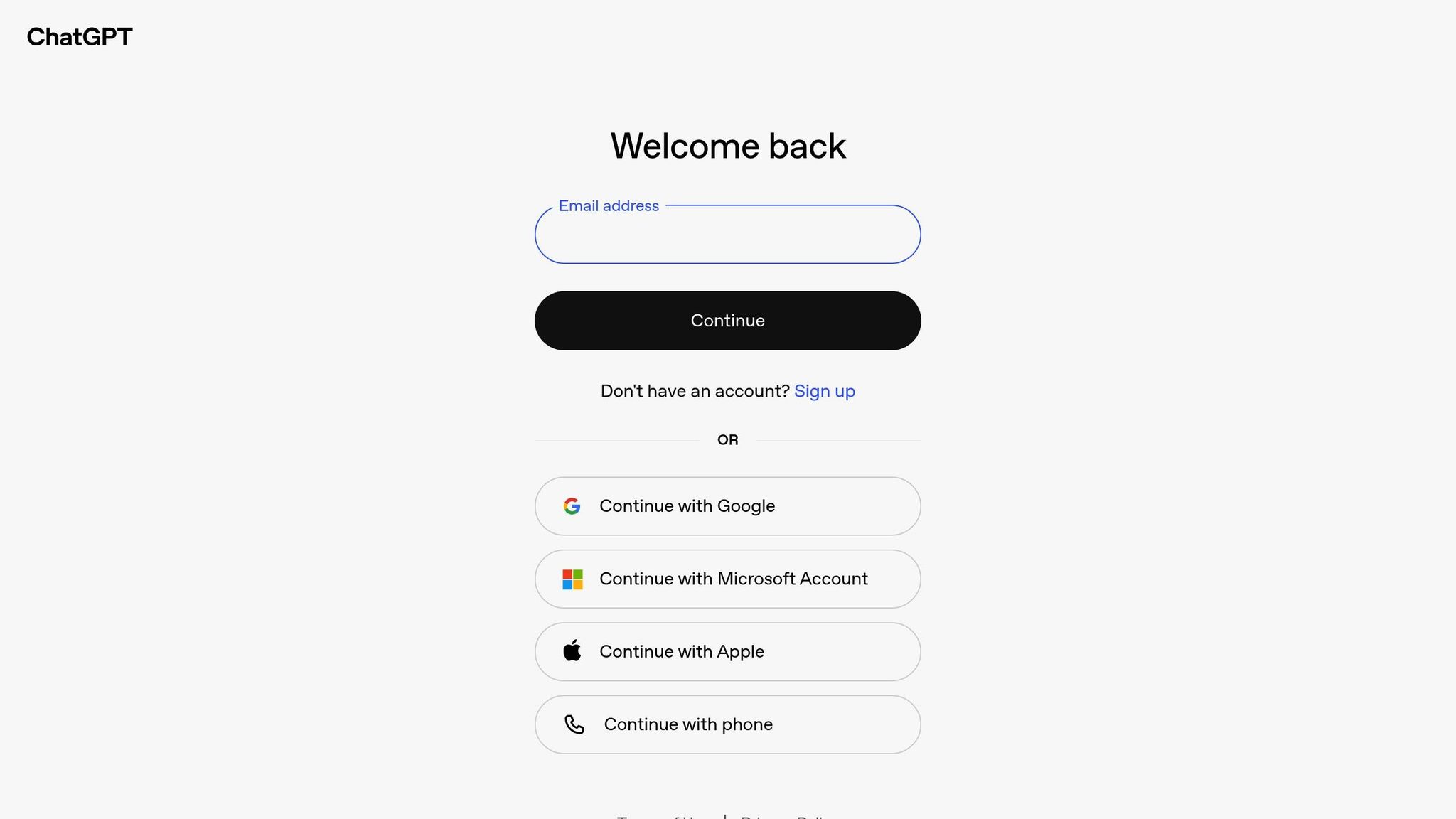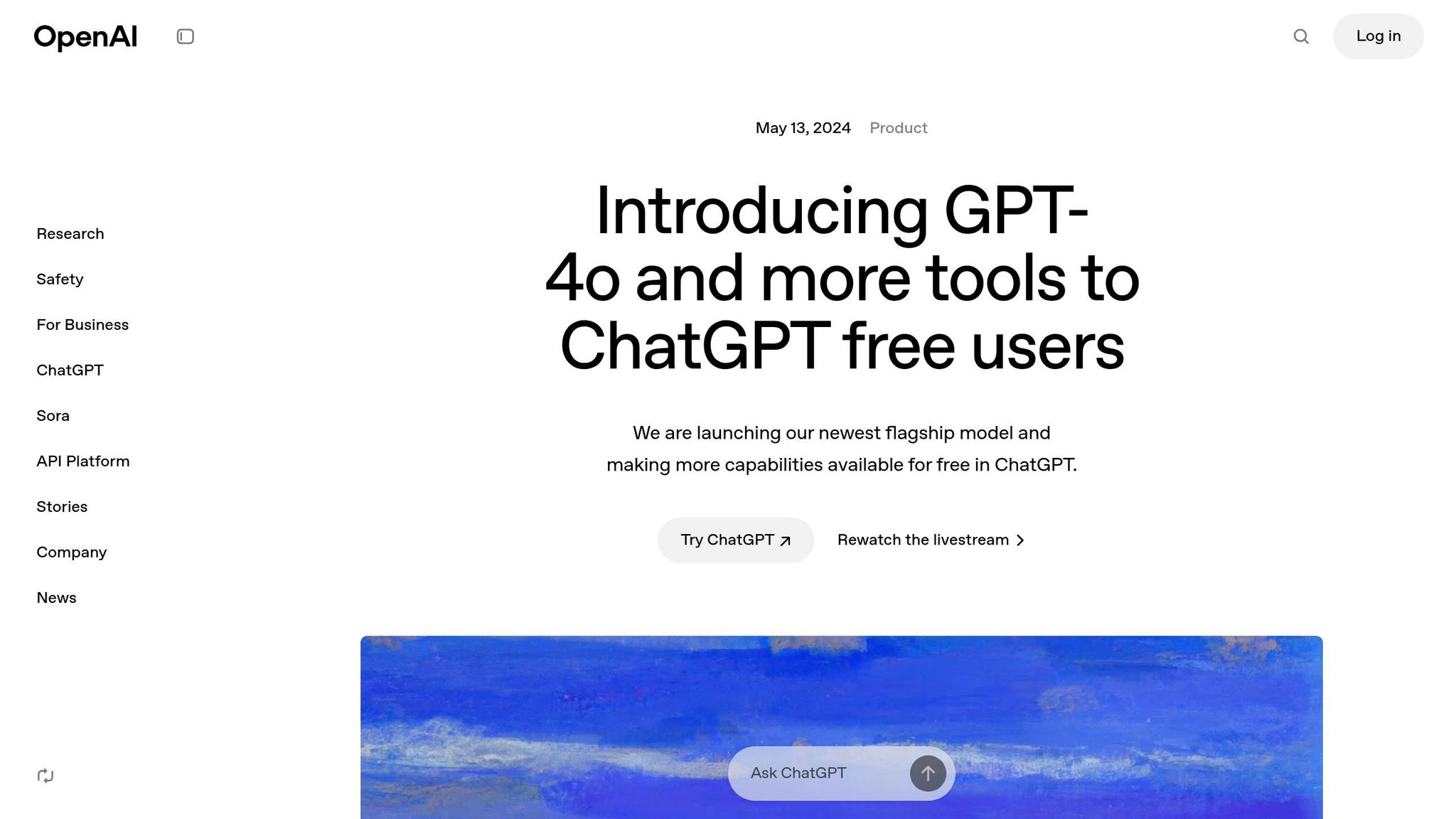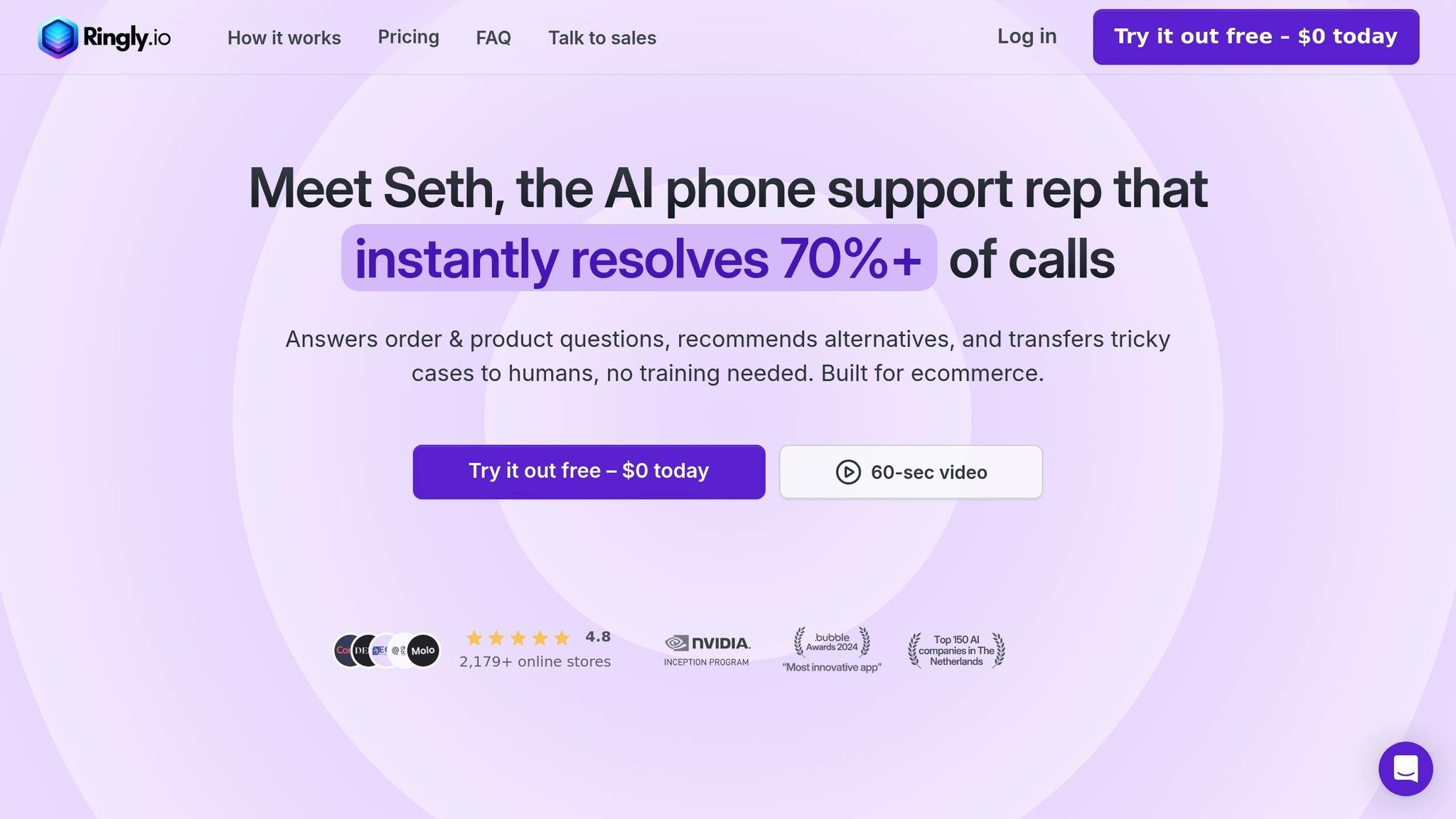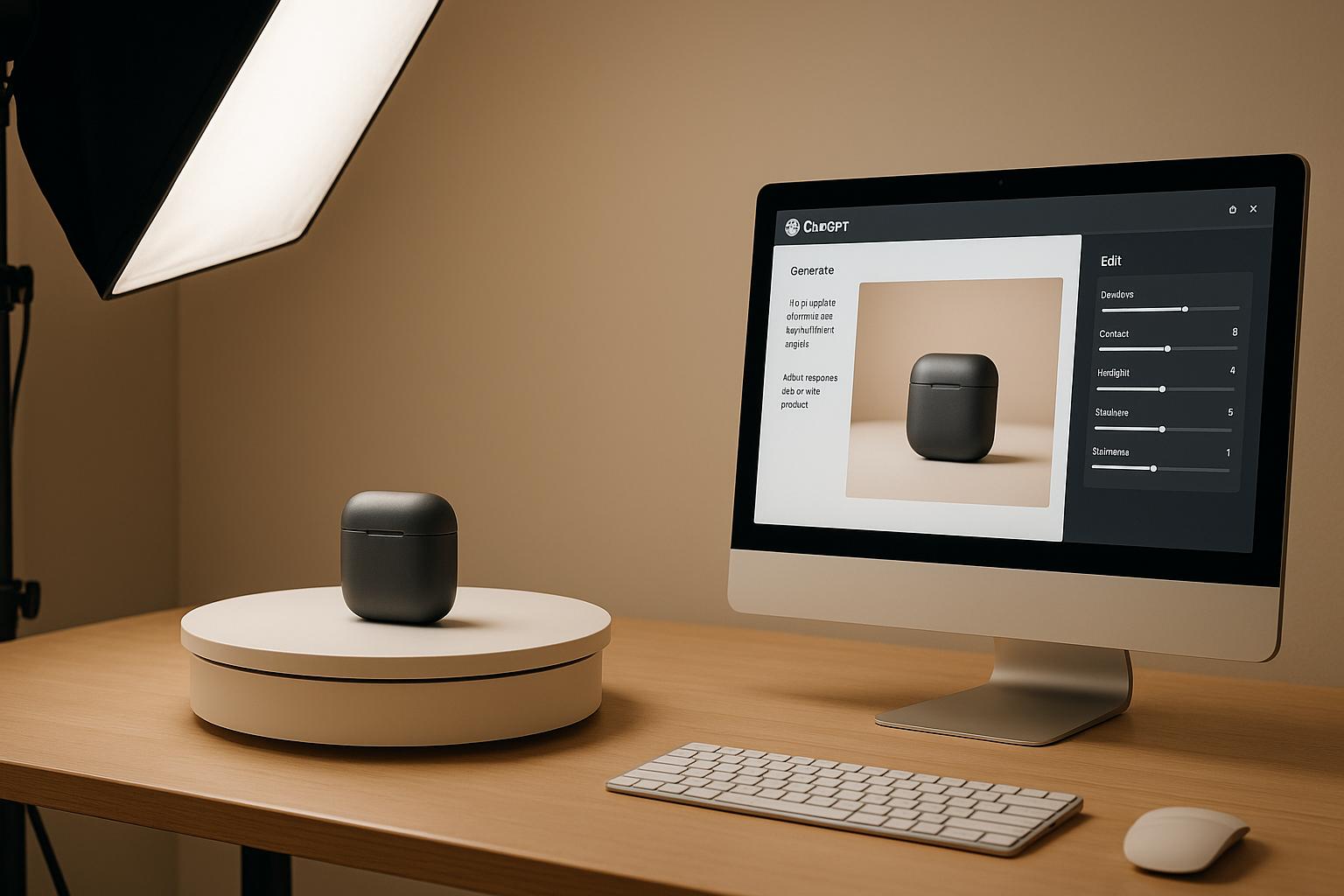AI-powered tools like GPT-4o are transforming product photography for e-commerce businesses. In 2025, you can create high-quality images quickly and affordably, bypassing traditional photography's high costs and time demands. Here's how GPT-4o simplifies the process:
- Cost Savings: Generate professional images for as little as $0.02–$0.19 per image, saving up to 80% on production costs.
- Speed: Produce polished visuals in minutes, reducing time-to-market for new products.
- Customization: Tailor images for platforms like Amazon or Instagram using specific prompts for lighting, angles, and backgrounds.
- Scalability: Create consistent visuals across large product catalogs with ease.
- Flexibility: Generate lifestyle, studio, or detailed shots without additional equipment or expertise.
This step-by-step guide explains how to use GPT-4o effectively, from preparing inputs to refining images, ensuring your e-commerce listings stand out. AI tools like GPT-4o are now essential for businesses aiming to stay competitive in the fast-evolving digital marketplace.
How I Use AI To Create PHOTO-REAL Product Images (ChatGPT Image Generator)

GPT-4o Image Generation for Product Photography

GPT-4o makes it easy for businesses to create professional-quality product images using simple text prompts. It fits naturally into conversations and is accessible to all business owners, regardless of technical expertise.
The demand for this technology is already clear. When image generation launched in ChatGPT, over 130 million users created more than 700 million images in just the first week. Now, let’s dive into how GPT-4o’s features make image creation precise, efficient, and versatile.
Key Features of GPT-4o for Image Generation
What sets GPT-4o apart is its ability to understand context and deliver highly accurate results. The model excels at rendering text accurately and following prompts to the letter. One standout feature is its ability to refine images iteratively. Instead of starting over with every change, GPT-4o remembers the conversation. You can simply say, “brighten the background” or “add more contrast to the product,” and it will adjust the existing image while preserving consistency. Impressively, it can handle prompts involving 10–20 different objects, making it perfect for detailed product arrangements or lifestyle scenes.
Another strength is its advanced text rendering. GPT-4o can place product labels, price tags, branding, or promotional text directly onto images, eliminating the need for additional graphic design. Its editing capabilities also allow you to tweak specific parts of an image - just highlight the area and type the change you want.
"GPT‑4o image generation excels at accurately rendering text, precisely following prompts, and leveraging 4o's inherent knowledge base and chat context - including transforming uploaded images or using them as visual inspiration." – OpenAI
Benefits of AI-Generated Product Photos
GPT-4o can generate multiple versions of product images in minutes, significantly speeding up the time it takes to bring products to market. Traditional photography often requires scheduling, setup, shooting, and post-processing, but GPT-4o bypasses all that.
It’s also incredibly cost-effective. Pricing starts around $0.02, $0.07, and $0.19 per image for low-, medium-, and high-quality square formats, respectively. This makes it a budget-friendly alternative to professional photo shoots.
Using consistent prompt patterns ensures uniformity across your product photos. You can maintain the same lighting, backgrounds, and product positioning for hundreds of items, which strengthens brand identity and builds trust with customers. Plus, GPT-4o’s scalability makes it easy to handle seasonal campaigns, new product launches, or catalog updates without the logistical headaches of traditional photography.
The creative flexibility is another major benefit. You can showcase your products in virtually any setting, from minimalist studio shots to detailed lifestyle scenes, without additional production costs. For example, GoDaddy is exploring ways to use image generation for creating editable logos, removing backgrounds, and designing professional typography.
US E-commerce Considerations
GPT-4o also caters to the specific needs of U.S. businesses. For example, it allows you to include culturally relevant elements like American home styles, seasonal themes tied to U.S. holidays, or lifestyle settings that resonate with local consumers.
When relevant, you can incorporate imperial measurements to ensure images match U.S. expectations. For example, defining a product as a “12-inch laptop” or a “6-foot dining table” ensures proper scaling. Pricing is another consideration - using “USD” or the dollar sign ($) makes images clear and familiar for American audiences. Additionally, you can tailor images to meet platform-specific requirements, such as “white background, 2000×2000 pixels, product centered, Amazon marketplace style,” to comply with major e-commerce guidelines.
Every image generated by GPT-4o includes C2PA metadata, which identifies it as AI-generated. This supports transparency and builds trust. Beyond product photography, GPT-4o’s potential extends to other areas. For instance, HubSpot is exploring ways to use it for creating marketing and sales materials, while Instacart is testing its API to generate visuals for recipes and shopping lists. These applications make GPT-4o a powerful tool for modern e-commerce, seamlessly blending visual content creation with broader AI-driven strategies discussed throughout this guide.
Step-by-Step Guide: Creating Product Images with GPT-4o
Producing professional product images with GPT-4o involves careful preparation and a structured approach. By turning basic product details into polished visuals, you can enhance your brand and boost sales.
Step 1: Gather Your Inputs
Start by assembling everything you'll need, including a ChatGPT Plus subscription with GPT-4o access. Collect detailed product information such as dimensions (use inches, feet, or pounds for U.S. markets), colors, materials, and any standout features. For instance, note specifics like "12×8×4 inches, genuine Italian leather, gold-tone hardware."
High-quality reference photos are crucial. Pick images that showcase your product clearly under good lighting. Consider removing backgrounds with tools like remove.bg to help GPT-4o focus on the product itself.
Don’t forget your branding essentials: logos, brand colors (hex codes), typography, and overall design style. Tailor your inputs to the platform you're targeting. For example:
- Amazon: High-resolution images with white backgrounds.
- Instagram: Square images with lifestyle elements.
Once your inputs are ready, you can move on to crafting precise prompts.
Step 2: Craft Clear and Detailed Prompts
The key to great results lies in how you write your prompts. Be specific and include all necessary details to guide GPT-4o effectively.
Set the scene by addressing the five W’s: who will use the product, what it is, when and where it’s used, and why the image is being created. For example: "Professional woman using wireless earbuds during a morning jog in Central Park, product photography for an e-commerce listing."
Incorporate technical details like:
- Background: Specify colors or settings, such as "white background" or "urban park during sunrise."
- Lighting: Use terms like "soft natural light from the left" or "even studio lighting."
- Camera Angles: Mention styles such as "close-up" or "wide-angle shot."
- Aspect Ratio: Include dimensions like "square format for Instagram."
For more complex images, break the process into steps: start with the background, then add the product, and finish with props or text. This layered approach ensures better control over the final image.
Step 3: Generate and Refine Your Image
Upload your reference photos and enter your crafted prompt into GPT-4o. The tool will use these inputs to create visuals that match your product specifications.
Review the initial output and make adjustments. Refine the image 3–5 times using clear, concise instructions. For example:
- "Increase brightness by 20%."
- "Add contrast to make the product stand out."
- "Reposition the product slightly to the center."
You can also experiment with different styles:
- Hero Images: For main product pages.
- Detail Shots: To highlight specific features.
- Lifestyle Images: Showcasing the product in real-world settings.
This variety will give you a comprehensive library of images to use across different platforms.
Step 4: Optimize for E-Commerce Platforms
Once your image is finalized, download it in high-quality PNG format. This format ensures lossless compression and supports transparent backgrounds when needed.
Resize the image to meet platform requirements:
- Amazon: 2000×2000 pixels.
- Instagram: 1080×1080 pixels.
Clearly label files with details like SKU, image type, and intended platform. Use editing tools to batch resize and optimize file sizes without compromising quality.
Finally, test your images on various devices to ensure they look sharp and professional across all screen sizes. Mobile optimization is especially important for e-commerce success.
sbb-itb-5521aa5
Prompt Templates for E-Commerce Categories
Creating effective prompts for product images requires tailoring them to each category. Different product types have unique demands, and the way you structure your prompts can make or break the final result. Below, you'll find templates specifically designed for Apparel, Electronics, and Home products.
Apparel and Fashion
Fashion photography is all about bringing out the fit, fabric, and style of clothing. Your prompts should focus on how the clothing looks on real people while emphasizing the features that influence buying decisions.
When crafting your prompt, include details about the model, pose, setting, lighting, and how the product is positioned. Example: "A woman in smart-casual attire stands in a bright, modern apartment, holding the [PRODUCT] with a relaxed smile. Morning sunlight streams through large windows, creating soft natural shadows. The product is sharply in focus with a shallow depth of field. Photographed in a professional editorial style".
For specific items, be clear about the size and material. Try this: "Professional product photo of a navy blue cotton t-shirt, US size medium, displayed on a fit model against a clean white background. The shirt shows natural draping and texture, with soft studio lighting highlighting the fabric quality."
If generated faces appear unnatural, adjust your prompt to focus on "hands only" or "partial view of person". This keeps the human touch while avoiding awkward facial features that could affect your brand's credibility.
Style-related keywords are crucial for setting the right tone. Use terms like "minimalist", "realistic", "photo shot", or "magazine-style fashion photo" to refine the look. For a more cinematic vibe, you can specify "shot like a movie still."
Electronics and Gadgets
When it comes to electronics, clarity and precision are key. Your prompts should highlight the product's design, functionality, and scale, helping customers understand both its appearance and practical use.
Detailed prompts work best for tech products. Include specifics like dimensions, connectivity features, and material finishes to guide the AI effectively.
Example: "High-resolution product photography of wireless Bluetooth earbuds in a matte black finish, displayed in an open charging case measuring 3×2×1 inches. The earbuds feature LED charging indicators and sleek metallic accents. Shot on a modern desk setup with soft diffused lighting and a clean white background."
For more complex gadgets, add a bit of context or a story to the prompt. This helps create visuals that feel more relatable and engaging.
Two common approaches for electronics are product mockups and studio photography. Mockups allow customers to imagine how the product fits into their lives, while studio shots emphasize technical details and build quality from various angles.
Don’t forget to specify image quality and style preferences. Words like "photorealistic", "high-resolution", and "studio-quality" ensure the product looks polished and professional.
Home and Living Products
Home products need to strike a balance between functionality and aesthetic appeal. The goal is to help customers visualize how the item will look and work in their own spaces.
Example: "Photorealistic image of a handcrafted ceramic vase, 12 inches tall with a 6-inch diameter, filled with fresh white peonies. The vase is placed on a rustic oak dining table in a bright, airy kitchen with natural morning light streaming through sheer curtains. Minimalist styling with soft shadows."
Stick to clean and simple design rules for home products. Ensure plenty of white space around the item, avoid clutter, and make sure any text or price tags are easy to read against the background.
Be specific about materials, dimensions, and placement. Phrases like "ceramic", "12 inches tall", or "hanging on wall" help the AI capture texture, scale, and context.
You can also experiment with different composition styles to find the best fit for your product. Options like "overhead flat lay", "three-quarter angle", or "lifestyle scene" can add variety and appeal.
For home products, incorporating lifestyle elements that resonate with US customers can make a big difference. Clean, well-lit settings and relatable home environments allow customers to picture the product in their own spaces, which can boost sales.
These templates can help you consistently generate high-quality images, making your e-commerce listings stand out.
Improving E-commerce Support with Ringly.io

Eye-catching visuals may grab attention, but it's efficient customer support that turns casual browsers into paying customers. That’s where Ringly.io steps in, playing a crucial role in your AI-powered e-commerce setup. By combining advanced imagery with responsive support, it pushes the boundaries of what a fully AI-driven e-commerce ecosystem can achieve.
Ringly.io Overview and Key Features
Ringly.io is an AI-driven phone agent platform that automates customer support for e-commerce businesses. Unlike traditional text-based chatbots, Ringly.io handles phone calls with AI-powered voices that sound natural, delivering a personalized and seamless customer experience.
The platform operates 24/7, managing both inbound and outbound calls. Whether customers are checking on order statuses, asking about products, or initiating returns, Ringly.io’s AI agents provide instant answers - no waiting on hold. It uses real-time speech-to-text technology to understand queries and responds with natural-sounding text-to-speech.
One standout feature is its ability to recover abandoned carts through personalized phone calls. The AI reaches out to customers who left items in their cart, addresses any concerns, and even sends SMS checkout links to encourage purchase completion. This proactive approach recovers 35% of abandoned carts.
Ringly.io supports 18 languages and integrates with over 7,000 tools, making it easy to connect with platforms like Shopify, WooCommerce, and others.
"This is such a great product. I have been with you for less than a week and already closed 3 deals with it."
– Jim Miranda, Founder Elite Sales & Automation
Combining AI Tools for Better Results
Ringly.io becomes even more powerful when paired with GPT-4o’s visual capabilities. Together, they create a well-rounded AI-powered e-commerce system. While GPT-4o-generated product images attract customers by showcasing items professionally, Ringly.io ensures every customer inquiry is handled quickly and effectively.
This combination is especially valuable during peak shopping seasons. Ringly.io can handle high call volumes with ease, managing over 15 calls at the same time. At just $0.15–$0.25 per call minute, it offers a cost-effective way to scale your customer support without sacrificing quality.
"What I like most about Ringly is that it allows me to see what issues were the most frequent. I can identify the key areas where users need the most help."
– Kevan Williams, Founder Ascendant
Both tools provide actionable analytics. GPT-4o helps determine which product visuals resonate most with customers, while Ringly.io highlights common customer concerns. This data allows you to refine your product presentation and customer service strategies to maximize impact.
AI Product Photography vs. AI Phone Support
| Feature | GPT-4o Product Photography | Ringly.io Phone Support |
|---|---|---|
| Primary Function | Generates professional product images | Handles customer phone calls |
| Availability | On-demand image creation | 24/7 phone support |
| Cost Structure | Pay per image generated | $99–$1,099/month plus per-minute charges |
| Scalability | Unlimited image generation | Manages 15+ simultaneous calls |
| Customer Impact | Improves visual appeal and conversions | Reduces wait times and boosts satisfaction |
| Integration | Works with design workflows | Integrates with e-commerce platforms |
| Learning Curve | Requires prompt engineering skills | Easy setup with templates |
| ROI Measurement | Tracks conversion rate improvements | Measures call resolution and cart recovery metrics |
These tools serve different stages of the customer journey. GPT-4o shines during the attraction and consideration phases, helping customers visualize products and make purchasing decisions. Ringly.io, on the other hand, excels during the support and retention phases, ensuring customer inquiries are resolved efficiently.
Ringly.io resolves 70% of calls without human intervention, freeing up your team to focus on more complex issues. Meanwhile, GPT-4o-generated images work tirelessly to present your products in the best light possible.
For U.S.-based e-commerce businesses, this integrated approach tackles two major challenges: reducing the cost of professional photography and providing scalable customer support across time zones. With Ringly.io’s support for 18 languages and accents, you can cater to a global audience without hiring multilingual staff.
Together, these AI solutions create a unified strategy that enhances both product presentation and customer satisfaction.
Conclusion: How AI Changes E-commerce
The e-commerce world is evolving fast, and AI tools like GPT-4o and Ringly.io are leading the charge. These technologies are becoming must-haves for businesses aiming to stay competitive in 2025 and beyond.
The numbers tell a clear story. The global AI-enabled e-commerce market was valued at $8.65 billion in 2025 and is expected to soar to $22.60 billion by 2032, with a compound annual growth rate of 14.60%. Companies that embrace AI see revenue increases of 10–12% and profitability jumps of 59%.
For small and medium-sized e-commerce businesses, the cost savings are especially appealing. GPT-4o mini, for instance, is 60% cheaper than GPT-3.5 Turbo, making professional-grade product photography accessible to businesses with limited budgets. At just $0.150 per 1 million input tokens and $0.600 per 1 million output tokens, generating hundreds of high-quality product images is far more affordable than a traditional photo shoot. These savings open the door to further operational improvements. Meanwhile, Ringly.io enhances customer support processes, cutting costs while improving efficiency.
AI-powered customer interactions are also on the rise. Currently, AI-driven chatbots manage 70% of online customer conversations, and by 2030, AI is expected to handle 80% of all customer interactions. On top of that, 93% of e-commerce businesses see AI agents as a key competitive edge.
The operational benefits go beyond just cost savings. AI can reduce stockouts by 30%, cut excess inventory by 20%, and deliver 5–10% savings in transportation and warehousing costs. These efficiencies build over time, creating advantages that traditional methods simply can’t match.
AI isn’t just an option anymore - it’s a necessity. Whether it’s creating stunning product images with GPT-4o or optimizing customer service with Ringly.io, today’s AI tools are reshaping e-commerce operations from the ground up.
The future of e-commerce belongs to those who combine eye-catching visuals with top-tier customer service - all powered by AI. The tools are ready, the costs are manageable, and the results are undeniable. The choice is yours: embrace the transformation or risk being left behind.
FAQs
How does GPT-4o create high-quality, consistent AI product images for e-commerce platforms?
GPT-4o creates top-tier AI-generated product images by using cutting-edge rendering technology and interpreting prompts with precision. The result? Images that look realistic, are visually striking, and can be tailored to meet the specific needs of various e-commerce platforms.
With its emphasis on detail and accuracy, GPT-4o enables businesses to present a polished and unified brand appearance across their online storefronts, helping them draw in and connect with customers more effectively.
How can I customize GPT-4o-generated product images to suit U.S. cultural and platform-specific requirements?
To make GPT-4o-generated images fit U.S. audiences and platform-specific expectations, focus on relevance and compliance. Choose visuals that reflect American norms, including appropriate clothing, symbols, and settings. Think about your audience's preferences, incorporating seasonal themes or holidays like Thanksgiving or the Fourth of July to create a stronger connection.
At the same time, ensure all visuals meet U.S. copyright laws and advertising standards. Confirm that AI-generated images are licensed for commercial use, steering clear of any elements that might violate intellectual property rights. When crafting prompts, also consider platform-specific needs - like image dimensions or formats for sites such as Amazon or Etsy - to ensure your visuals are perfectly suited for their purpose.
Can GPT-4o create complex product images, like multi-object setups or lifestyle scenes, and how does it compare to traditional photography?
GPT-4o is capable of producing detailed product images, including setups with multiple objects and intricate lifestyle scenes. Its advanced AI tools allow for creating visually striking and customizable visuals that can align with specific requirements.
That said, when it comes to highly intricate designs or compositions that demand precise details, lighting, or textures, traditional photography still holds the edge. This method offers unmatched precision and control for capturing the finer aspects of an image.
In essence, GPT-4o is a fantastic choice for creating efficient and budget-friendly product imagery. However, traditional photography remains the go-to option for projects that demand a higher level of artistic or technical sophistication.




.avif)
.avif)
.avif)
.avif)
.avif)
.avif)

